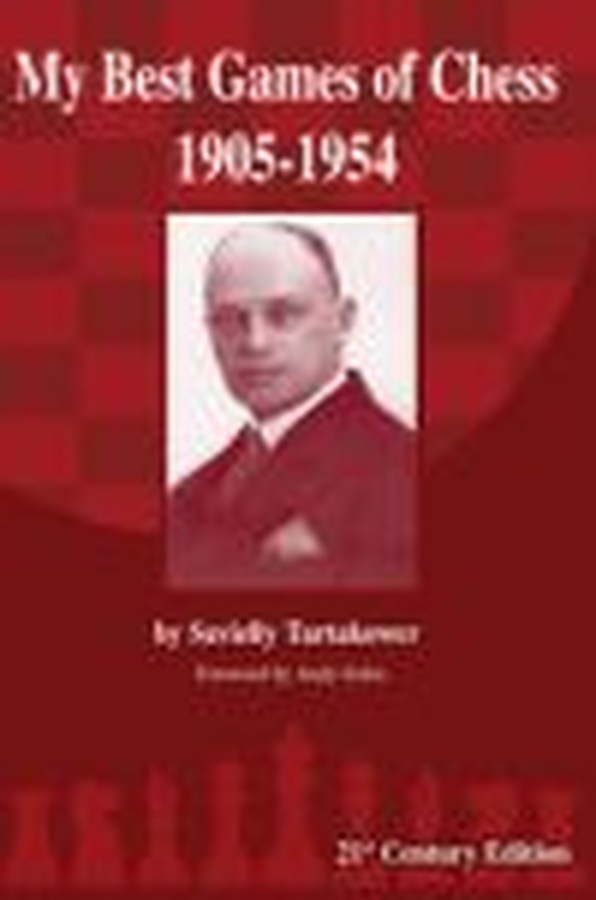| Nivå | B-D |
| Utgivelsesdato | September 2015 |
| Forfatter | |
| Pris | 440 NOK |
My Best Games of Chess 1905-1954
21st Century EditionEndelig på engelsk og med riktig sjakknotasjon: Tartakower, den kanskje største sjakkforfatteren, kommenterer blant annet 201 partier fra sin stolte, lange karriere.
En begivenhet at denne boka blir tilgjengelig for et helt nytt publikum, som ikke har lest Tartakowers forlengst utsolgte klassikere på tysk. Verken partiene eller skrevne ord rekker vel noen gang å bli kjedelige hos Tartakower.
Forlagets egen omtale:
The Unique Genius of Tartakower!
One of the most creative grandmasters ever to play the Royal Game was Savielly Tartakower. His combination of bold play and fascinating writing has long endeared him to chess aficionados worldwide.
Tartakower’s annotations are unlike any other master of his time. He repeatedly stressed the psychological nature of chess, for example. His classic work of best games has never been available in English algebraic notation. Until now.
Experience the unique genius of Savielly Tartakower in this 21st Century Edition of his games collection – 201 games, 49 game fragments, all deeply annotated and quintessentially Tartakower!
GM Andy Soltis in his Foreword:
“This book was meant to do what all great annotations do: instruct, explain, and entertain. And it succeeds spectacularly.”
Fra utgiveren Taylor Kingstons innledning:
If, with the literate, I am Impelled to try an epigram, I never seek to take the credit; We all assume that Oscar said it. Dorothy Parker, on Oscar Wilde
To those familiar with chess history and literature, Savielly Tartakower oc- cupies a unique place, rather analogous to Oscar Wilde, as the game’s foremost wit and aphorist. His pungent observations have become so ingrained in common chess parlance that when one is used (e.g., “The winner of a chess game is he who makes the next-to-last mistake,” or “Dubious, therefore playable,” or “Any open- ing is good if its reputation is bad enough,” to mention only three of many) chances are the speaker is not aware that he’s quoting Tartakower.
And, on the other hand, as with Dorothy Parker’s above quip about Wilde, when a bit of chess wit is credited, chances are it’s assumed to be Tartakower’s, whether it is or not. His cosmopolitan breadth of intellect, his sophisticated vo- cabulary, his erudite allusions, his talent for eloquence, satire, irony, paradox, epigram, and sardonic drollery make his writings among the most sparkling and enjoyable in all of chess literature, and they stand in sharp contrast to the usual dry “if ... then” recitation of analytical variations so common to modern game collections.
Yet, well deserved though this widespread recognition of Tartakower’s lit- erary talent is, it has involved a certain injustice (or at least imbalance) because it has tended to overshadow his talents as a chess player. In this regard, I present myself as Exhibit A. While a half-century’s immersion in chess literature has enabled me to recite from memory dozens of Tartakower witticisms and anec- dotes – of course, I knew he was one of the greatest players of all time – until editing this book, I had, except for some of his losses to more famous contempo- raries such as Lasker, Capablanca, and Alekhine, played through probably no more than a half-dozen of his games.
Working on this book has corrected that imbalance in my chess education. Had I realized what I was missing, it would have been corrected long ago for Tartakower’s play is, if anything, more sparkling, pungent, and enjoyable than his writing. And, like his erudition, it is both broad and deep. He is capable of wild flights of tactical fantasy; see, for example, his games against Schlechter at St. Petersburg 1909 (game 16), Maróczy at Teplitz-Schönau 1922 (game 43), Lazard at Paris 1929 (game 89), Sultan Khan (11th match game, 1931; game 104) or Wood at Southsea 1949 (game 182). Yet, he was also a master of posi- tional play, as his games against Asztalos at Budapest 1913 (game 23), Thomas at Hastings 1945-46 (game 162), and Benkner at Paris, 1953 (game 198) attest. His endgame technique was truly that of a world-class grandmaster, as demonstrated by his games against Rosselli at Semmering 1926 (game 67), Réti at Hastings 1926-27 (game 74), Keres at Warsaw 1935 (game 135), and Klein (Position XXVIII); bearing special mention in this vein is his remarkable zigzag queen maneuver against Lowcki at Jurata 1937 (game 150).
He was also a master of psychology, always varying his opening and style to put his opponent off-balance. See, for example, how he discomfits Schlechter with a new twist on the Old Indian Defense (game 31), or Rubinstein with the Blumenfeld Counter-Gambit (game 45), or Tarrasch with the Nimzovitch Sicil- ian (game 87), or Pilnik with the Barry Attack (game 189). On the other hand, he could also neutralize over-eager ambition with solid play, as against Takacs at Budapest 1926 (game 69).
In openings, Tartakower had one of the most varied repertoires ever seen. He was as comfortable in romantic gambits (King’s, Vienna, Evans, Falkbeer, etc.) as in ultra-closed lines (e.g., the Réti and Catalan Systems). He was fond of eccentric and experimental lines (e.g., the Orangutang, the Basque, 2.g3 against the both the French and Sicilian), and games 20 to 23 practically constitute a primer on Bird’s Opening ( 1.f4 ). He had a well-deserved reputation as a leader of the Hypermodern movement, even coining the term and playing, besides the Réti and Catalan as White, just about every Indian Defense there is as Black, often fianchettoing both bishops with either color. Yet, he loved reviving dusty old double king pawn lines (e.g., the Ponziani, Philidor’s Defense, and 3.Be2 in the King’s Gambit), and one of the most frequently seen openings in both volumes is the decidedly un-hypermodern Orthodox Defense of the Queen’s Gambit De- clined.
...
Along with his reputation for wit, Tartakower was also regarded as rather a cynic. If so, one could hardly blame him; losing one’s parents in a pogrom and struggling to survive two world wars (in both of which he saw military service, first with Austria-Hungary and then with the Free French) could embitter anyone. He occasionally brings out a poison pen in these pages; see, for example, the sarcastic barbs aimed at Lasker in game 17, or his comments about the “Yugoslav variation” in game 64. Yet, taking the book as a whole, it is clear that whatever cynicism Tartakower felt hardly made him a misanthrope, quite the opposite. Any such tendencies were more than balanced by genuine joy: joy in life in general, and joy specifically in the thrills, beauty, infinite variety, depth, and mystery chess offers. We invite the reader to explore with him.
| Innbundet? | Nei |
| Type | Bok |
| Språk | Engelsk |
| Antall sider | 437 |
Se også
-

My Best Games of Chess 1908-1937 21st Century Edition
KjøpDen som ikke har og leser Aljechins partisamlinger på tysk, eller på engelsk med deskriptiv notasjon, får denne store sjansen til å sikre seg dette høydepunktet i sjakklitteraturens samlet under ett.
- Pris
- 445
- Nivå
- B-D
- Av
- Utgivelsesdato
- Juni 2013

